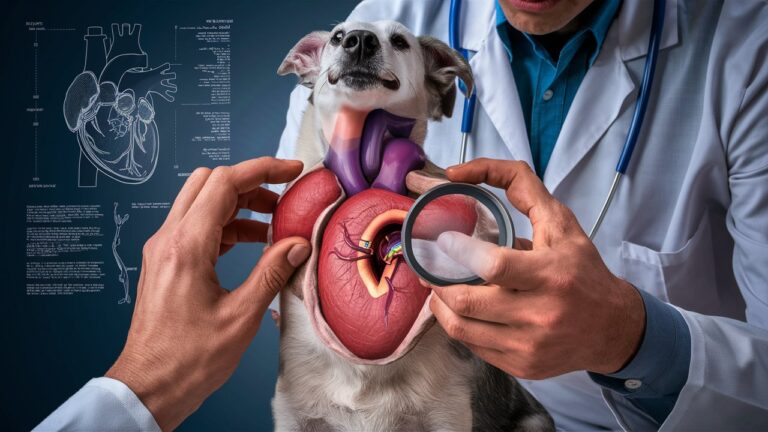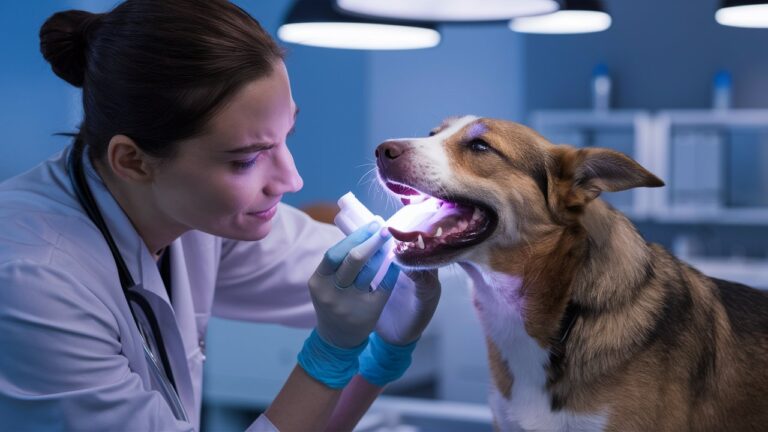Thrombopathia in Dogs: 100% Comprehensive Diagnosis, Management, and Care
Thrombopathia in dogs, a term denoting platelet function disorders, can significantly impact a dog’s health and well-being. Dogs with this condition experience abnormal blood clotting, which can lead to a range of health issues, from mild bruising to severe internal bleeding. This article aims to provide a comprehensive overview of thrombopathia in dogs, discussing its causes, symptoms, diagnosis, treatment, and management. Through detailed research and personal anecdotes, we hope to shed light on this often-misunderstood condition, helping dog owners and veterinary professionals alike to better care for affected animals.
Table of Contents
ToggleUnderstanding Thrombopathia in Dogs
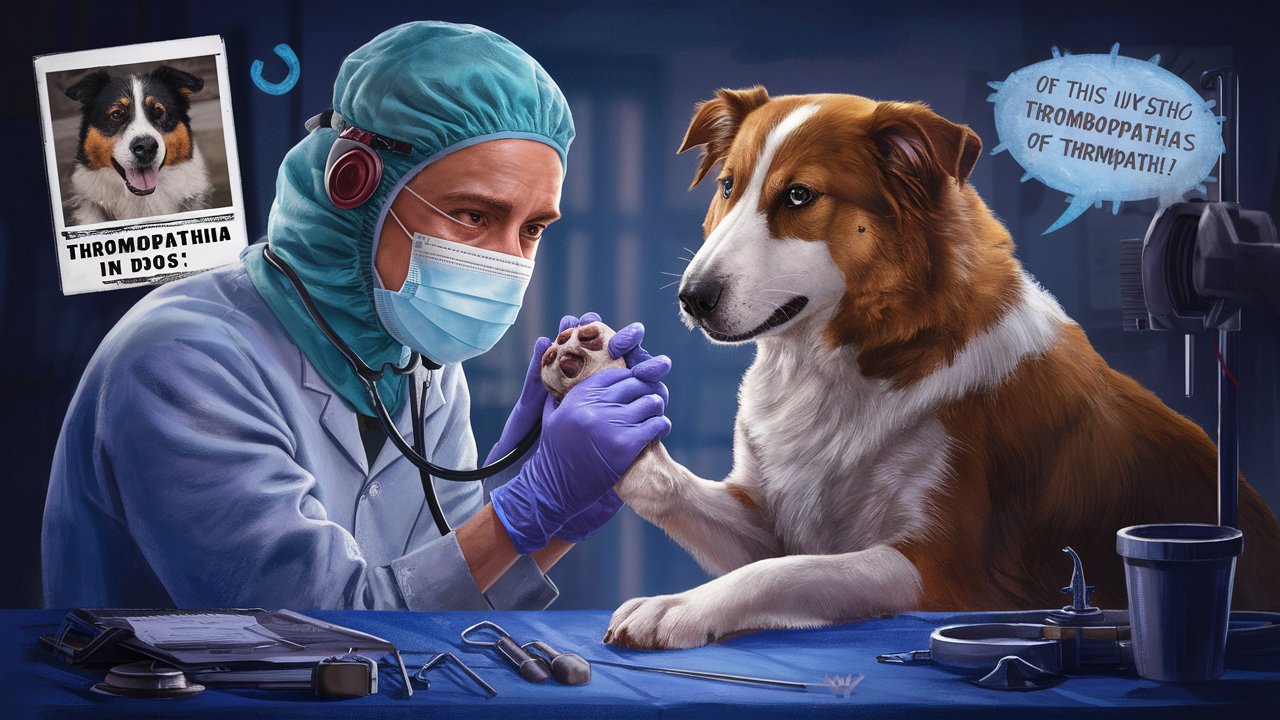
What is Thrombopathia in Dogs?
Thrombopathia in dogs refers to a group of disorders characterized by the abnormal functioning of platelets, the blood cells responsible for clotting. Unlike thrombocytopenia, where there is a low platelet count, thrombopathia involves a normal number of platelets that do not work properly. This dysfunction can lead to prolonged bleeding times, even from minor injuries.
Causes of Thrombopathia in Dogs
Thrombopathia in dogs can be congenital (inherited) or acquired.
- Congenital Thrombopathia in dogs: Some breeds are genetically predisposed to Thrombopathia in Dogs. For example, Basset Hounds and Spitz breeds are known to have inherited platelet function disorders. This type of thrombopathia is usually due to mutations in the genes responsible for platelet function.
- Acquired Thrombopathia in dogs: This can result from various factors, including exposure to certain drugs (such as non-steroidal anti-inflammatory drugs), underlying diseases (like kidney disease or certain cancers), or immune system disorders.
Symptoms of Thrombopathia in Dogs
Recognizing the symptoms of thrombopathia in dogs is crucial for early diagnosis and effective management. Common symptoms include:
- Prolonged Bleeding: Dogs with thrombopathia may bleed for an extended period even from minor cuts or injuries.
- Bruising: Unexplained bruising can occur, particularly on the gums, under the skin, or in the eyes.
- Nosebleeds: Frequent or prolonged nosebleeds can be a sign of platelet dysfunction.
- Blood in Urine or Stool: This can indicate internal bleeding.
- Excessive Bleeding During Surgery or Dental Procedures: Dogs with thrombopathia often experience significant bleeding during and after surgical or dental interventions.
Diagnosing Thrombopathia In Dogs
Diagnosing thrombopathia in dogs involves a series of detailed and specific tests to assess platelet function, differentiate it from other blood disorders, and determine the underlying cause. This diagnostic process is crucial for formulating an effective treatment and management plan. Here, we delve into the various steps and methods used to diagnose thrombopathia in dogs:
1. Comprehensive Medical History and Physical Examination
The diagnostic journey begins with a thorough medical history and physical examination. The veterinarian will ask detailed questions about the dog’s symptoms, such as:
- Frequency and duration of bleeding episodes
- Instances of unexplained bruising or hematomas
- Any history of nosebleeds or blood in urine/stool
- Previous reactions to surgeries or injuries
- Family history, especially if the dog is a breed known to have genetic predispositions to blood disorders
The physical examination includes checking for signs of bleeding, such as petechiae (small red or purple spots caused by bleeding under the skin), ecchymoses (larger bruises), and gingival bleeding. The vet will also assess overall health to rule out other potential causes of bleeding, such as liver disease or vitamin deficiencies.
2. Complete Blood Count (CBC)
A Complete Blood Count (CBC) is a fundamental test in diagnosing blood disorders. The CBC measures the number of red blood cells, white blood cells, and platelets in the blood. For thrombopathia:
- Platelet Count: The platelet count is usually normal in thrombopathia, as the condition affects platelet function rather than quantity. However, this test is crucial to rule out thrombocytopenia (low platelet count) as a cause of bleeding.
- Other Parameters: The CBC also helps identify any concurrent conditions that might contribute to the dog’s symptoms, such as anemia or infection.
3. Platelet Function Tests
Specific tests to assess platelet function are essential to confirm a diagnosis of thrombopathia. These tests evaluate how well platelets adhere, aggregate, and function to form clots. Key platelet function tests include:
- Buccal Mucosal Bleeding Time (BMBT): This test involves making a small incision on the dog’s gum and measuring the time it takes for bleeding to stop. Prolonged bleeding time suggests a platelet function disorder.
- Platelet Aggregation Tests: These tests assess the ability of platelets to clump together (aggregate) in response to various agents like ADP, collagen, or epinephrine. Abnormal aggregation patterns indicate platelet dysfunction.
- Clot Retraction Test: This test evaluates the ability of platelets to contract and stabilize a blood clot. Poor clot retraction suggests a functional defect in the platelets.
4. Genetic Testing
For breeds known to have inherited forms of thrombopathia in dogs, genetic testing can provide a definitive diagnosis. Genetic tests identify specific mutations associated with platelet function disorders. These tests are particularly useful for:
- Confirming a Diagnosis: In breeds like Basset Hounds or Spitz, genetic testing can confirm the presence of known mutations.
- Breeding Decisions: Genetic testing helps breeders make informed decisions to avoid passing the condition to future generations.
5. Bone Marrow Examination
In some cases, a bone marrow biopsy may be necessary to further evaluate platelet production and rule out other underlying conditions. This invasive procedure involves extracting a small sample of bone marrow, typically from the hip bone, for examination under a microscope. The bone marrow examination can:
- Assess Platelet Production: Determine if platelets are being produced normally in the bone marrow.
- Identify Other Disorders: Rule out conditions like leukemia or myelodysplastic syndromes that can affect platelet production and function.
6. Additional Laboratory Tests
Additional tests may be conducted to rule out other causes of bleeding and to assess overall health:
- Coagulation Profile: Tests like Prothrombin Time (PT) and Activated Partial Thromboplastin Time (aPTT) evaluate the coagulation cascade. Normal results in these tests, along with abnormal platelet function tests, support a diagnosis of thrombopathia.
- Biochemical Panel: This panel assesses organ function, including liver and kidney health, which can influence bleeding tendencies.
- Urinalysis: Analyzing the urine helps detect blood or other abnormalities that could indicate internal bleeding or kidney issues.
Case Study: Diagnosing Thrombopathia in Dogs in Max
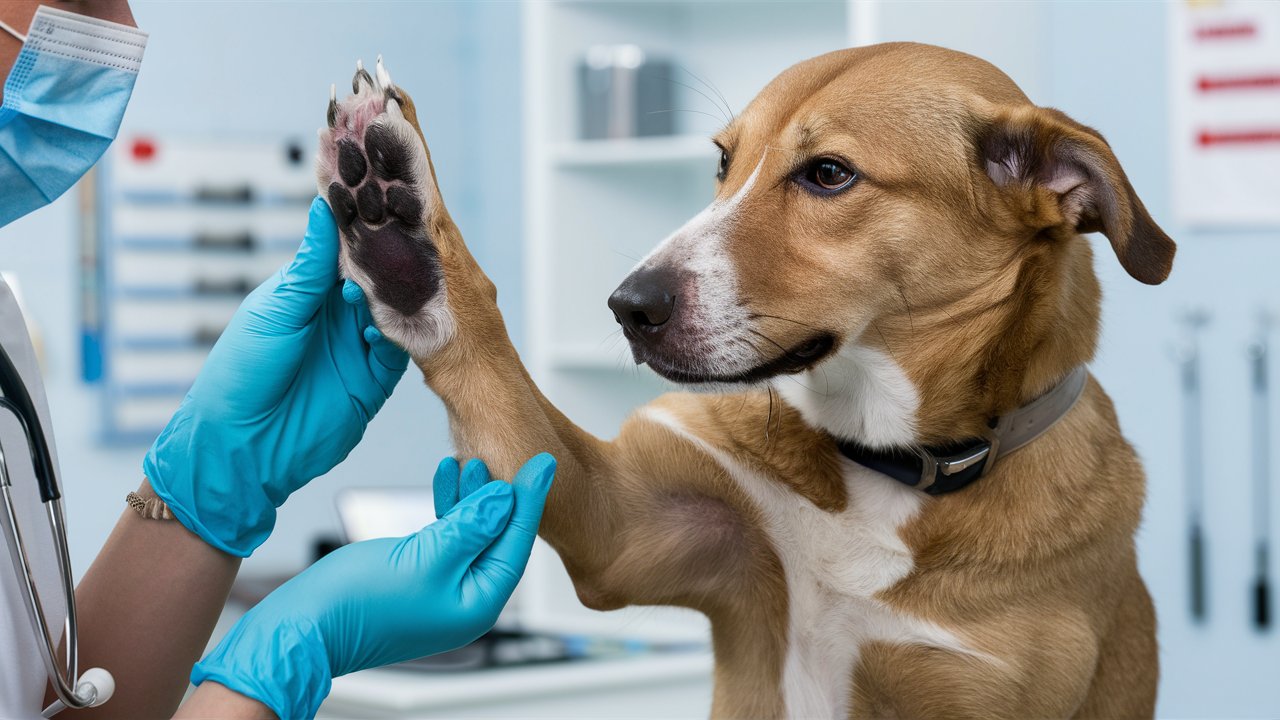
Max, a 4-year-old Basset Hound, was brought to the veterinarian after his owners noticed frequent nosebleeds and prolonged bleeding from minor cuts. During the initial consultation, the vet gathered a detailed medical history, noting that Max had bled excessively during a previous dental cleaning. A physical examination revealed small bruises on his abdomen and gums.
The vet ordered a CBC, which showed a normal platelet count but mild anemia. Given Max’s breed and symptoms, the vet proceeded with specific platelet function tests. The Buccal Mucosal Bleeding Time (BMBT) was significantly prolonged, and platelet aggregation tests showed abnormal responses to collagen and ADP.
Genetic testing confirmed a mutation associated with inherited thrombopathia in Basset Hounds. Additional tests, including a coagulation profile and biochemical panel, ruled out other potential causes of bleeding.
With a confirmed diagnosis of thrombopathia in dogs, the vet worked with Max’s owners to develop a comprehensive management plan, including avoiding certain medications, monitoring for signs of bleeding, and regular veterinary check-ups.
Treatment and Management of Thrombopathia in Dogs
Managing thrombopathia in dogs involves a multifaceted approach that includes medical management, supportive care, and lifestyle adjustments. Each dog’s condition is unique, so treatment plans must be tailored to individual needs, ensuring the best possible quality of life. Below is a detailed discussion on various aspects of treating and managing thrombopathia in dogs.
Medical Management
1. Medications:
- Desmopressin (DDAVP): This synthetic hormone is often used in the treatment of thrombopathia. Desmopressin can temporarily increase the levels of von Willebrand factor and improve platelet function. It is usually administered before surgical procedures or in cases of active bleeding.
- Antifibrinolytic Agents: Medications such as aminocaproic acid and tranexamic acid help prevent the breakdown of blood clots, thereby reducing bleeding. These drugs are particularly useful during and after surgical procedures.
- Platelet Function Enhancers: While specific platelet enhancers are not commonly used in veterinary medicine, ongoing research may lead to new drugs that can directly improve platelet function in dogs with thrombopathia.
2. Avoiding Certain Drugs:
- Dogs with thrombopathia should avoid medications that can exacerbate bleeding. Non-steroidal anti-inflammatory drugs (NSAIDs), such as aspirin and ibuprofen, are known to impair platelet function and should be avoided unless specifically recommended by a veterinarian.
- Some antibiotics and other medications can also affect platelet function or increase bleeding risk, so it’s essential to review all medications with a veterinarian.
Supportive Care
1. Wound Care:
- Prompt Attention to Injuries: Any cuts, scrapes, or wounds should be addressed immediately to prevent excessive bleeding. Applying pressure to the wound and using bandages or clotting agents can help control bleeding.
- Clotting Agents: Products like styptic powders or gels can be used to promote clotting in minor wounds. For more severe bleeding, veterinary intervention may be necessary.
2. Regular Veterinary Check-ups:
- Monitoring Health: Regular visits to the veterinarian are crucial for monitoring the dog’s condition. Blood tests and physical examinations can help assess the effectiveness of the management plan and detect any new issues early.
- Adjusting Treatment Plans: As the dog ages or if the condition progresses, adjustments to the treatment plan may be necessary. Regular check-ups ensure that any changes are made promptly and appropriately.
Lifestyle Adjustments
1. Activity Restrictions:
- Avoiding Rough Play: Dogs with thrombopathia should avoid activities that could lead to injuries, such as rough play, jumping from heights, or high-impact sports. Gentle exercise, like walking on a leash, is typically safer.
- Safe Environment: Creating a safe home environment is essential. This includes removing sharp objects, providing non-slip flooring, and ensuring the dog has a comfortable place to rest.
2. Diet and Nutrition:
- Balanced Diet: Providing a well-balanced diet is crucial for overall health. Good nutrition supports the immune system and promotes healing. Discuss dietary options with a veterinarian to ensure all nutritional needs are met.
- Supplements: In some cases, dietary supplements like vitamin K, which plays a role in clotting, may be recommended. However, supplements should only be given under veterinary supervision.
3. Grooming and Dental Care:
- Gentle Grooming: Regular grooming is important, but it should be done gently to avoid cuts and abrasions. Using soft brushes and avoiding sharp grooming tools can help prevent injuries.
- Dental Hygiene: Good dental hygiene is essential to prevent gum bleeding. Regular teeth brushing with a dog-safe toothpaste and periodic dental cleanings by a veterinarian can help maintain oral health.
Comprehensive Care Approach
Effective management of thrombopathia requires a comprehensive approach that combines medical treatment, supportive care, and lifestyle adjustments. By working closely with a veterinarian and following a tailored management plan, dog owners can help their pets lead comfortable and fulfilling lives.
Collaboration with Veterinary Specialists
1. Hematologists:
- Veterinary hematologists specialize in blood disorders and can provide advanced diagnostic and treatment options. They can offer insights into the latest research and potential new treatments for thrombopathia.
2. Geneticists:
- For breeds prone to inherited thrombopathia, geneticists can conduct tests to confirm diagnoses and identify carriers. This information is valuable for breeders and helps in making informed decisions about breeding practices.
3. Veterinary Surgeons:
- When surgical procedures are necessary, working with experienced veterinary surgeons who understand the complexities of thrombopathia is crucial. They can take extra precautions to minimize bleeding risks during and after surgery.
Advances in Veterinary Medicine about Thrombopathia in Dogs

1. Research and Innovations:
- Ongoing research in veterinary medicine continues to improve the understanding and management of thrombopathia. New diagnostic techniques, such as advanced genetic testing and platelet function assays, are enhancing early detection and accurate diagnosis.
- Experimental treatments, including gene therapy, offer hope for long-term solutions to inherited thrombopathia. While these treatments are still in the research phase, they hold promise for future breakthroughs.
2. Multidisciplinary Approaches:
- Collaborative efforts among veterinary specialists ensure comprehensive care for dogs with thrombopathia. These multidisciplinary approaches address all aspects of the condition, from diagnosis and treatment to ongoing management and support.
Personal Anecdotes and Stories About Thrombopathia in Dogs
A Story of Hope: Buddy’s Journey with Thrombopathia in Dogs
Buddy, a 5-year-old Basset Hound, was diagnosed with thrombopathia after his owners noticed he bled excessively from minor cuts and bruised easily. Initially, Buddy’s family was overwhelmed by the diagnosis, fearing they could not provide the care he needed. However, with guidance from their veterinarian, they developed a comprehensive management plan.
Regular check-ups, careful wound care, and lifestyle adjustments, such as using a harness instead of a collar to avoid neck injuries, became part of their routine. Despite the challenges, Buddy continued to enjoy a happy and active life, participating in gentle activities and receiving lots of love and attention from his family.
Buddy’s story highlights the importance of early diagnosis and proactive management in improving the quality of life for dogs with thrombopathia. His journey is a testament to the resilience of pets and the dedication of their owners.
Advances in Veterinary Medicine
Advancements in veterinary medicine are crucial in improving the diagnosis, treatment, and management of thrombopathia in dogs. As research progresses, new technologies and therapies are being developed, providing hope for better outcomes for dogs affected by this condition. Here are some of the notable advances:
Research and Innovations
- Advanced Diagnostic Techniques
- Genetic Testing: Genetic testing has become a cornerstone in diagnosing congenital thrombopathia in dogs. Advances in molecular genetics have enabled the identification of specific gene mutations responsible for platelet function disorders. For example, DNA sequencing techniques can pinpoint mutations in genes like those encoding for platelet surface glycoproteins, which are crucial for platelet adhesion and aggregation.
- Platelet Function Assays: Improved platelet function assays are now available, offering more accurate and detailed analysis of platelet activity. These assays can measure various aspects of platelet function, such as adhesion, aggregation, and secretion, providing a comprehensive picture of platelet health.
- Innovative Treatments
- Gene Therapy: Gene therapy is an emerging field in veterinary medicine with the potential to correct genetic defects at their source. For dogs with inherited thrombopathia, gene therapy aims to introduce functional copies of defective genes into the animal’s genome, thereby restoring normal platelet function. While still in experimental stages, early studies in animal models show promising results, indicating that gene therapy could one day offer a long-term solution for genetic platelet disorders.
- Stem Cell Therapy: Stem cell therapy is being explored as a treatment for various hematological disorders, including thrombopathia. Mesenchymal stem cells (MSCs), known for their regenerative properties, may help improve platelet function and reduce bleeding tendencies. Research is ongoing to determine the efficacy and safety of stem cell therapy in canine patients with thrombopathia.
- Pharmacological Advancements
- New Medications: Research into new medications that can enhance platelet function or prevent excessive bleeding is ongoing. For instance, scientists are developing drugs that target specific pathways involved in platelet activation and aggregation. These medications could offer more effective and targeted treatment options for dogs with thrombopathia.
- Desmopressin (DDAVP): Desmopressin, a synthetic hormone, has shown promise in improving platelet function in dogs with certain types of thrombopathia. It works by stimulating the release of von Willebrand factor (vWF) from endothelial cells, which enhances platelet adhesion and aggregation. While not a cure, desmopressin can provide temporary relief from bleeding symptoms during surgical procedures or in emergency situations.
Collaborative Efforts
- Multidisciplinary Approaches
- Veterinary Hematologists: Specialized veterinarians with expertise in hematology play a critical role in diagnosing and managing thrombopathia. They collaborate with general practitioners to develop tailored treatment plans, monitor patient progress, and adjust therapies as needed.
- Geneticists: Veterinary geneticists are essential in diagnosing inherited thrombopathia through genetic testing. They also contribute to research aimed at understanding the genetic basis of platelet disorders and developing potential gene therapies.
- Pharmacologists: Veterinary pharmacologists work on developing and testing new drugs to treat thrombopathia. Their research includes studying the pharmacokinetics and pharmacodynamics of new medications, ensuring they are safe and effective for canine patients.
- Educational Programs
- Continuing Education for Veterinarians: Ongoing education is crucial for veterinarians to stay updated on the latest advances in diagnosing and treating thrombopathia. Conferences, workshops, and online courses provide opportunities for veterinarians to learn about new research findings, diagnostic techniques, and treatment options.
- Public Awareness Campaigns: Raising awareness about thrombopathia among dog owners and breeders is essential for early detection and management. Educational campaigns can help owners recognize the symptoms of thrombopathia and seek veterinary care promptly.
Technological Innovations
- Next-Generation Sequencing (NGS): NGS technology allows for the rapid sequencing of entire genomes, providing detailed information about genetic mutations associated with thrombopathia. This technology has revolutionized the field of veterinary genetics, enabling more accurate and comprehensive genetic testing.
- Point-of-Care Diagnostics: Portable diagnostic devices are being developed to provide quick and accurate platelet function tests at the point of care. These devices can be used in veterinary clinics to rapidly assess platelet health and guide treatment decisions.
- Telemedicine: Telemedicine platforms enable veterinarians to consult with specialists remotely, facilitating access to expert advice and second opinions. This is particularly valuable for veterinarians in rural or underserved areas who may not have direct access to veterinary hematologists or geneticists.
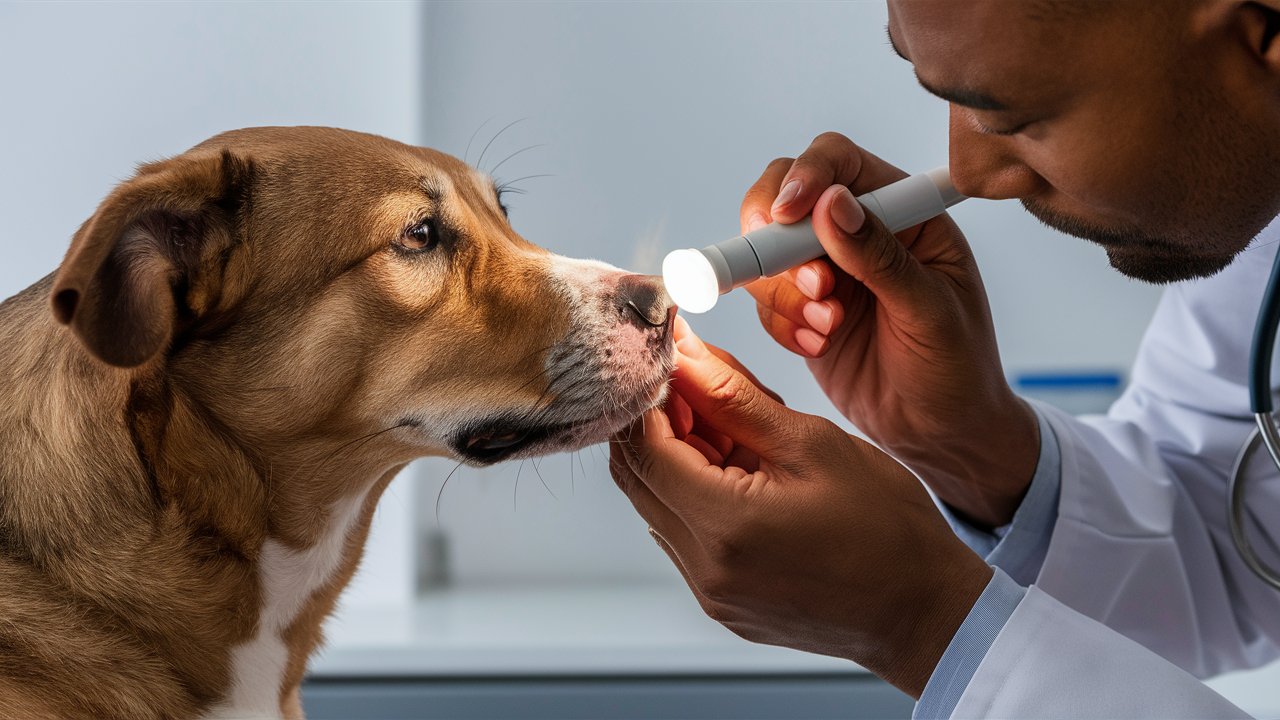
Conclusion
Thrombopathia in dogs is a complex condition that requires a thorough understanding and a multifaceted approach to management. By recognizing the symptoms, obtaining an accurate diagnosis, and implementing effective treatment and management strategies, dog owners can significantly improve the quality of life for their furry companions. Personal stories, like Buddy’s, remind us of the resilience of pets and the profound impact of dedicated care.
As veterinary medicine continues to advance, there is hope for even better outcomes for dogs with thrombopathia. By staying informed and working closely with veterinary professionals, dog owners can navigate the challenges of this condition and provide the best possible care for their beloved pets.
Additional Resources
For those seeking more information on thrombopathia and related platelet function disorders, consider consulting the following resources:
- Veterinary Hematology Textbooks: Comprehensive guides on blood disorders in animals, offering in-depth information on thrombopathia.
- Breed-Specific Health Organizations: Many breed clubs and organizations provide resources and support for owners of dogs with inherited conditions.
- Veterinary Specialists: Hematologists and geneticists can offer expert advice and advanced diagnostic and treatment options.
By staying informed and proactive, dog owners can ensure their pets live happy, healthy lives despite the challenges of thrombopathia.

